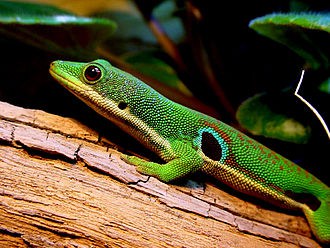Type the name of the breed you're looking for below
[wpdreams_ajaxsearchlite] Don't see the breed your're looking for? Click here and let us know!
Peacock Day Gecko
| Place of Origin and Range | It is endemic to Madagascar, where it is a common to abundant, widespread reptile. |
| Description | Dark spots behind the front legs, a second set of spots on each side of the body in front of the hind legs. The body colouration is mainly green with reddish markings down the back. |
| Morph Patterns Available | Yes |
| Adult Size | Can grow up to 3.5 in (9 cm) |
| Accommodation | These animals should be housed in pairs and need a medium sized terrarium. The temperature should be between 25 and 28°C. The humidity should be not too high. Most geckos prefer warm habitat with lots of shade, hides, and lots of branches for climbing. Provide a small water dish and mist twice daily. Cover the sides of the cage when possible to prevent injury to your gecko from running into glass. |
| Lifespan | Can live 6+ years |
| Feeding / Diet | Feeds on a variety of insects and fruit. |
| Breeding | Hatching is likely to take just over six weeks. The neck area of the females tends to swell prior to egg laying as a result of calcium deposits, which are used to form the eggs. |
| Other Considerations | Healthy geckos with appropriate living conditions shed regularly. They shed completely and often eat their shed to the point where the keeper may not even notice that the gecko has shed. Some geckos experience shedding problems occasionally and others chronically have difficulty shedding. Signs of shedding difficulty range from large sheets of shed clinging to the head, tail or limbs to residual shed left around the eyes, on the tail tip or the toes. This shed must be removed since it can cause constrictive damage to the extremities. All geckos require calcium to maintain strong bones and vitamin D3 to aid in metabolizing the calcium. Calcium is generally supplied in powdered form in a bowl, through dusted feeders or as an ingredient in fruit. |



